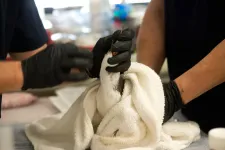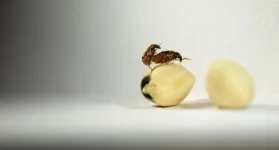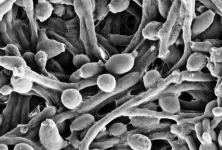INFORMATION:
Building an Evidence Base for Integration of Social Care Into Health Care: Our Collective Path Ahead
Alicia J. Cohen, MD, MSc, FAAFP, Center of Innovation in Long Term Services and Supports, VA Providence Healthcare System; Departments of Family Medicine and Health Services, Policy, and Practice, Brown University, Providence, Rhode Island. Department of Family Medicine, University of Michigan, Ann Arbor, Michigan.
Emilia H. De Marchis, MD, MAS, Department of Family & Community Medicine, University of California, San Francisco
https://www.annfammed.org/content/19/4/290
Integration of social care into health care: Our collective path ahead
Researchers, policy makers, health care systems and payers all play a part in meeting patient social care needs
2021-07-14
(Press-News.org) Drs. Alicia Cohen and Emilia De Marchis provide commentary on three articles in this issue of Annals of Family Medicine, specifically Greenwood-Ericksen et al's research on Michigan's Federally Qualified Health Centers; Hoeft et al's special report about translating lessons learned from behavioral health integration into the social care realm; and Fessler et al's narrative about how they as medical students stepped away from their medical clerkships to act as community volunteers for people experiencing homelessness during the COVID-19 pandemic. All three articles serve as a timely call to action, reminding those in health care that work remains to meet the needs of patients, particularly in screening for and intervening on identified social risks. The urgency of this work has only been heightened by the pandemic as patients face new or intensified socio-economic hardships. Cohen and De Marchis write that collaboration is needed among researchers, policy makers, payers and health care systems to assist in identifying evidence-based practices for social needs integration. This includes improved training and education for all clinical care team members about social risk and social care activities, best practice guidelines, evidence-based interventions, and sustainable funding streams. Social risk data can also more broadly aid advocacy and policy efforts to expand community-based resources, efforts to address health inequities, and population health-level interventions. Cohen and De Marchis note that greater flexibility in using Center for Medicare & Medicaid dollars and the new 2021 Evaluation and Management coding guidelines for social determinants may help with more consistent funding for social care activities. "The path ahead requires working together and sharing learnings to advance our common goal of achieving health equity and wellness--for patients and the health care workforce alike," they write.
ELSE PRESS RELEASES FROM THIS DATE:
Detecting wildlife illness and death with new early alert system
2021-07-14
From domoic acid poisoning in seabirds to canine distemper in raccoons, wildlife face a variety of threats and illnesses. Some of those same diseases make their way to humans and domestic animals in our increasingly shared environment.
A new early detection surveillance system for wildlife helps identify unusual patterns of illness and death in near real-time by tapping into data from wildlife rehabilitation organizations across California. This system has the potential to expand nationally and globally. It was created by scientists at the University of California Davis' School of Veterinary Medicine with partners at the California Department of Fish and Wildlife ...
Small molecule plays outsize role in controlling nanoparticle
2021-07-14
ITHACA - Ligands are much like nanosized barnacles, binding to many kinds of surfaces. This form of adsorption is crucial for a range of chemical processes, from purification and catalysis to the design of nanomaterials.
However, understanding how ligands interact with the surface of nanoparticles has been a challenge to study. Adsorbed ligands are difficult to identify because there are other molecules in the mix, and nanoparticle surfaces are uneven and multifaceted, which means they require incredibly high spatial resolution to be scrutinized.
Cornell researchers led by Peng Chen, the Peter J.W. Debye Professor of Chemistry in the College of Arts and Sciences, have used a breakthrough imaging technique they ...
The hidden culprit killing lithium-metal batteries from the inside
2021-07-14
ALBUQUERQUE, N.M. -- For decades, scientists have tried to make reliable lithium-metal batteries. These high-performance storage cells hold 50% more energy than their prolific, lithium-ion cousins, but higher failure rates and safety problems like fires and explosions have crippled commercialization efforts. Researchers have hypothesized why the devices fail, but direct evidence has been sparse.
Now, the first nanoscale images ever taken inside intact, lithium-metal coin batteries (also called button cells or watch batteries) challenge prevailing theories and could help make future high-performance batteries, such as for electric vehicles, safer, more powerful and longer lasting.
"We're learning that we should be using separator materials tuned for ...
Melanoma of the eye: Preclinical tests show path toward treatment
2021-07-14
BIRMINGHAM, Ala. - Uveal melanoma, or UM, is a rare and deadly cancer of the eye, and the mortality rate has remained unimproved for 40 years. Half of the melanomas spread to other organs of the body, causing death in less than a year, so new treatments to preserve vision and prevent death are an urgent need.
Now a preclinical study by researchers at the University of Alabama at Birmingham and Emory University, Atlanta, offers hope -- a small molecule inhibitor has been identified that dampens the potent drivers of this tumor. In mouse models, the inhibitor, KCN1, strongly limited primary disease in the eye and metastatic tumor dissemination ...
Male beetles' spiny genitalia both harmful and beneficial to females
2021-07-14
Male seed beetles with genital structures that injure females may have greater reproductive success. As new research from Uppsala University shows, females that mate with such males benefit, in the sense that their offspring are healthier. This new piece of the puzzle will help scientists to understand how complex mating interactions between males and females have developedevolved. The study is published in Proceedings of the Royal Society B.
"This helps us understand is connected with the evolutionary dance between males and females of all animal species, ...
Scientists identify new gut-liver drug recycling process
2021-07-14
A team of University of Houston pharmaceutical researchers is reporting a newly recognized process of drug metabolism in the intestines - followed by recycling through the liver - that could have important implications for developing treatments for intestinal diseases and for taking multiple medications at the same time.
"The intestines play a crucial role in metabolizing and recycling certain plant compounds and drugs," reports Ming Hu, Diana S-L. Chow Endowed Professor of Drug Discovery and Development and the senior author of the paper in eLife. "The discovery has important implications for scientists trying to understand how ...
USGS-led study helps in the fight against the coronavirus pandemic
2021-07-14
A new study led by the U.S. Geological Survey outlines a means to better estimate COVID-19 occurrence and trends in populations.
Currently, COVID-19 testing is primarily limited to self-selected individuals, many of whom are symptomatic or have had contact with someone who is symptomatic. While these tests are useful for individual medical treatment and contact tracing, they do not provide health officials with a complete picture of the disease across the population.
"Coordinated sampling of COVID-19 is key to informing health officials as they continue their efforts to control the pandemic, permitting better predictions of disease dynamics and ...
Antibiotics in early life could affect brain development
2021-07-14
Antibiotic exposure early in life could alter human brain development in areas responsible for cognitive and emotional functions, according to a Rutgers researcher.
The laboratory study, published in the journal iScience, suggests that penicillin changes the microbiome - the trillions of beneficial microorganisms that live in and on our bodies - as well as gene expression, which allows cells to respond to its changing environment, in key areas of the developing brain. The findings suggest reducing widespread antibiotic use or using alternatives when possible to prevent neurodevelopment problems.
Penicillin and related medicines (like ampicillin and amoxicillin) are the most widely used antibiotics in ...
Hydrogel composite developed to help protective gear rapidly degrade toxic nerve agents
2021-07-14
Scientists at Northwestern University in Evanston, Illinois have developed a hydrogel integrated with zirconium-based robust metal-organic frameworks (MOFs) that rapidly degrades organophosphate-based nerve agents used in chemical warfare. Unlike existing powdered MOF adsorbents, this hydrogel composite does not require added water and may be easily scaled up for use in protective masks or clothing. The work appears July 14 in the journal Chem Catalysis.
"Organophosphate-based nerve agents are among the most toxic chemicals known to humanity," says senior author Omar Farha, a professor of chemistry at Northwestern University. "Their use in recent global conflicts reflects the urgent need for personal protective gear, as well as the bulk destruction of ...
Fungi that live in the gut influence health and disease
2021-07-14
(Salt Lake City) - Bacteria's role in gut health has received a lot of attention in recent years. But new research led by scientists at END ...
LAST 30 PRESS RELEASES:
Non-opioid ‘pain sponge’ therapy halts cartilage degeneration and relieves chronic pain
AI can pick up cultural values by mimicking how kids learn
China’s ecological redlines offer fast track to 30 x 30 global conservation goal
Invisible indoor threats: emerging household contaminants and their growing risks to human health
Adding antibody treatment to chemo boosts outcomes for children with rare cancer
Germline pathogenic variants among women without a history of breast cancer
Tanning beds triple melanoma risk, potentially causing broad DNA damage
Unique bond identified as key to viral infection speed
Indoor tanning makes youthful skin much older on a genetic level
Mouse model sheds new light on the causes and potential solutions to human GI problems linked to muscular dystrophy
The Journal of Nuclear Medicine ahead-of-print tip sheet: December 12, 2025
Smarter tools for peering into the microscopic world
Applications open for funding to conduct research in the Kinsey Institute archives
Global measure underestimates the severity of food insecurity
Child survivors of critical illness are missing out on timely follow up care
Risk-based vs annual breast cancer screening / the WISDOM randomized clinical trial
University of Toronto launches Electric Vehicle Innovation Ontario to accelerate advanced EV technologies and build Canada’s innovation advantage
Early relapse predicts poor outcomes in aggressive blood cancer
American College of Lifestyle Medicine applauds two CMS models aligned with lifestyle medicine practice and reimbursement
Clinical trial finds cannabis use not a barrier to quitting nicotine vaping
Supplemental nutrition assistance program policies and food insecurity
Switching immune cells to “night mode” could limit damage after a heart attack, study suggests
URI-based Global RIghts Project report spotlights continued troubling trends in worldwide inhumane treatment
Neutrophils are less aggressive at night, explaining why nighttime heart attacks cause less damage than daytime events
Menopausal hormone therapy may not pose breast cancer risk for women with BRCA mutations
Mobile health tool may improve quality of life for adolescent and young adult breast cancer survivors
Acupuncture may help improve perceived breast cancer-related cognitive difficulties over usual care
Nerve block may reduce opioid use in infants undergoing cleft palate surgery
CRISPR primes goldenberry for fruit bowl fame
Mass General Brigham announces new AI company to accelerate clinical trial screening and patient recruitment
[Press-News.org] Integration of social care into health care: Our collective path aheadResearchers, policy makers, health care systems and payers all play a part in meeting patient social care needs






